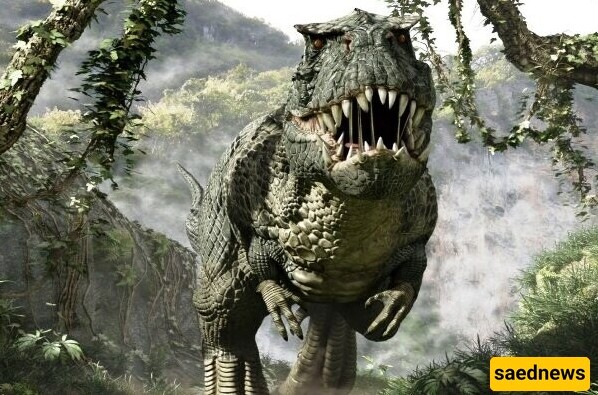Saednews: T. rex is one of the most amazing creatures in Earth’s history, and because of its size, strength, and terrifying appearance, it continues to attract the attention of scientists and dinosaur enthusiasts. This dinosaur is a symbol of the dinosaur era and the grandeur of nature in ancient times.

According to Saednews, Tyrannosaurus rex, abbreviated as T. rex, is one of the most famous and terrifying carnivorous dinosaurs in Earth’s history. It lived during the Late Cretaceous period (around 68 to 66 million years ago) and is known as one of the largest land predators of the Mesozoic Era.
Key Features:
Size and Weight:
Body length: about 12 to 15 meters
Height at the hips: about 4 meters
Weight: between 6 to 9 tons
Large Skull and Strong Teeth:
T. rex’s skull could be up to 1.5 meters long.
Its teeth were 15 to 20 centimeters long, well-suited for cutting and crushing bones.
Small Arms:
T. rex had small arms with two fingers, very short in comparison to its body.
Despite their small size, these arms were likely very powerful but did not play a significant role in hunting.
Powerful Legs:
Its long, muscular legs helped it run at speeds of 20 to 30 kilometers per hour.
Excellent Vision and Sense of Smell:
T. rex’s forward-facing eyes gave it excellent binocular vision.
Its strong sense of smell helped it track prey from long distances.
Habitat: T. rex lived in regions that are now known as North America. These areas included forests, rivers, and vast plains, providing an ideal environment for hunting and feeding.
Diet: T. rex was an opportunistic hunter and scavenger. Its diet included large herbivorous dinosaurs such as Triceratops and Edmontosaurus.
Social Behavior: It is still unclear whether T. rex lived alone or in groups, though there is evidence of social behavior in some theropods.
Extinction: T. rex and other dinosaurs went extinct at the end of the Cretaceous period (about 66 million years ago) due to a massive event such as a meteor impact or volcanic activity.
Popularity in Popular Culture: T. rex has become a symbol of dinosaurs in popular culture and is prominently featured in films, games, and books, including the Jurassic Park series.
T. rex is one of the most amazing creatures in Earth’s history, and due to its size, power, and terrifying appearance, it continues to capture the attention of scientists and dinosaur enthusiasts. This dinosaur symbolizes the age of dinosaurs and the grandeur of nature in ancient times.
Scientific Evidence: Scientific evidence suggests that Tyrannosaurus rex may have had feathers during part of its life, but not fully covered like modern birds.

Scientific Evidence:
Fossil Footprints of T. rex Relatives: Smaller species of the Tyrannosauridae family, such as Dilong paradoxus (early tyrannosaurs), have been found with fossil evidence of feathers.
This suggests that feathers may have existed in early members of this family and were inherited.
Purpose of Feathers:
Thermal insulation: In early and younger dinosaurs, feathers may have acted as insulation against cold.
Display and communication: Feathers could have been used for display to attract mates or scare off predators.
Large Size of Tyrannosaurus rex: Due to its large size and active metabolism, the adult T. rex likely did not require a full body covering for thermal insulation.
It is possible that T. rex had feathers only on parts of its body, such as the tail, neck, or shoulders.

Specific Fossil Evidence for T. rex: No direct fossils of feathers from T. rex have been found, but fossilized skin from this dinosaur shows that parts of its body had scaly skin. This does not mean its entire body was without feathers, but rather that, alongside scales, parts of its body were likely covered with feathers.
Conclusion: Based on fossil evidence and studies of T. rex’s relatives, it is possible that this dinosaur had feathers during its early life or on certain parts of its body, but it likely did not have a full coat of feathers. Research in this area is ongoing, and more information may emerge in the future.

